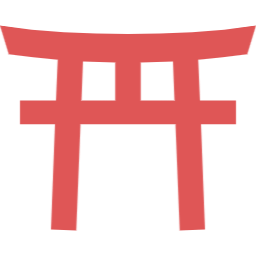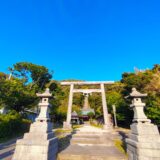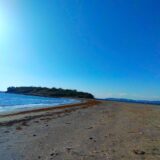目次
- 【Awa Shrine summary】
- 【Awa Shrine first torii】
- 【Awa Shrine road approaching a shrine】
- 【Awa Shrine Mitaraike Pond (Mitaraike)】
- 【Awa Shrine Chozuya】
- 【Awa Shrine subordinate shrine Itsukushima Shrine】
- 【Awa Shrine Upper shrine】
- 【Awa Shrine cave site】
- 【Awa Shrine Lower shrine】
- 【Awa Shrine GOSHUIN】
- 【Awa Shrine Nearby attractions】
- 【Awa Shrine Access】
- Manager’s Comments
- Awa Shrine
【Awa Shrine summary】
Awa Shrine was founded in 660 B.C. (the first year of the Imperial era). Amatomi-no-mikoto (the deity of the lower shrine) received an order from Emperor Jinmu to seek fertile land, and first landed in Awa-no-kuni (present Tokushima Prefecture), where he planted hemp and grain (kaji = raw material for paper and other products), and proceeded to cultivate the land. Later, in search of more fertile land, Amatomi-no-mikoto and his party, accompanied by a part of the Imobe clan living in Awa Province, rode the Kuroshio Current to the southern tip of the Boso Peninsula, where they also planted hemp and grain. At this time, Amatomi-no-mikoto enshrined his ancestors, Ama-no-Otama-no-mikoto and Ama-no-Hiritono-no-mikoto, on the two mountains of Nurahama (Male God Mountain and Female God Mountain), which is the origin of the present Awa Shrine.
The deity is Ametamatodamakoto. Many businessmen and executives visit the shrine to pray for “luck in business, good fortune, and prosperity. When industry develops, the area becomes prosperous and the people living there become rich. The reason why Awa Shrine is called a shrine of “luck in money” is because its deity is a god that promotes the development of industry.
Awa Shrine is also known as one of the three major money-luck shrines in Japan.
Japan’s three major money shrines are Arayayama Shrine in Yamanashi Prefecture, Kinzurugi Shrine in Ishikawa Prefecture, and Awa Shrine in Chiba Prefecture.
【Awa Shrine first torii】
Ichino-torii, the first torii gate, is visible in an open area that has been transformed from a residential area. The impressive white torii gate, set against the greenery, clearly delineated the boundary between the shrine and the sacred area.
![Awa Shrine [Chiba] DSC 1806 1024x768 - Awa Shrine [Chiba]](https://japan-shrine.info/wp-content/uploads/DSC_1806-1024x768.jpg)
【Awa Shrine road approaching a shrine】
![Awa Shrine [Chiba] DSC 1807 1 1024x768 - Awa Shrine [Chiba]](https://japan-shrine.info/wp-content/uploads/DSC_1807-1-1024x768.jpg)
The approach from the torii gate is lined with cherry trees, and if you go there when the cherry trees are in bloom, the view will be even better.
【Awa Shrine Mitaraike Pond (Mitaraike)】
![Awa Shrine [Chiba] DSC 1844 1024x768 - Awa Shrine [Chiba]](https://japan-shrine.info/wp-content/uploads/DSC_1844-1024x768.jpg)
Walking along the approach to the shrine, you will see a large pond. It is rare to see such a large pond at a shrine. The name suggests that people used to wash their hands before praying here.
![Awa Shrine [Chiba] DSC 1810 1 1024x768 - Awa Shrine [Chiba]](https://japan-shrine.info/wp-content/uploads/DSC_1810-1-1024x768.jpg)
Walking along the approach to the shrine, past the second torii gate, you will see the shrine office and water closet.
【Awa Shrine Chozuya】
![Awa Shrine [Chiba] DSC 1813 1 1024x768 - Awa Shrine [Chiba]](https://japan-shrine.info/wp-content/uploads/DSC_1813-1-1024x768.jpg)
It is a traditional Chozuya with no decoration.
【Awa Shrine subordinate shrine Itsukushima Shrine】
![Awa Shrine [Chiba] DSC 1842 1 1024x768 - Awa Shrine [Chiba]](https://japan-shrine.info/wp-content/uploads/DSC_1842-1-1024x768.jpg)
Itsukushima Shrine is located in front of the Awa Shrine worship hall. The moss-covered rock surface and tree roots attached to the rocks give a sense of age. The shrine enshrines the deity Ichikishimahime no Mikoto.
【Awa Shrine Upper shrine】
![Awa Shrine [Chiba] DSC 1830 1024x768 - Awa Shrine [Chiba]](https://japan-shrine.info/wp-content/uploads/DSC_1830-1024x768.jpg)
The Upper shrine enshrines Amenetodamanomikoto, the general ancestor of Japanese industry. The hall of worship was built in 1977 and is a reinforced concrete Shinmei-zukuri structure. The main shrine is located behind the hall of worship, but it is off-limits so that visitors cannot go around it. The main hall was built in 1881.
![Awa Shrine [Chiba] DSC 1827 1024x768 - Awa Shrine [Chiba]](https://japan-shrine.info/wp-content/uploads/DSC_1827-1024x768.jpg)
The configuration of the upper and lower shrines and the Mitarashi Pond were built in a manner reminiscent of the Ise Jingu Shrine, and the atmosphere was similar. In addition, it is thought that the arrangement was made with the male and female deities of Nurahama in the background.
【Awa Shrine cave site】
![Awa Shrine [Chiba] DSC 1822 1024x768 - Awa Shrine [Chiba]](https://japan-shrine.info/wp-content/uploads/DSC_1822-1024x768.jpg)
Behind the main shrine (Upper shrine), there is a sea cave about 11 m long, 2 m high, and 1.5 m wide. Twenty-two human bones, shell bracelets, earthenware, and other items were excavated from the cave, and it was found to be the burial place of ancient people. The human bones excavated here were again buried in Miyanotani near Awa Shrine and named Imobezuka
【Awa Shrine Lower shrine】
![Awa Shrine [Chiba] DSC 1836 1 1024x768 - Awa Shrine [Chiba]](https://japan-shrine.info/wp-content/uploads/DSC_1836-1-1024x768.jpg)
The lower shrine enshrines Amatomi-no-mikoto, who led the Awa Imobe to pioneer the Awa and Boso regions.
【Awa Shrine GOSHUIN】
![Awa Shrine [Chiba] awajinjya g 719x1024 - Awa Shrine [Chiba]](https://japan-shrine.info/wp-content/uploads/awajinjya-g-719x1024.jpg)
【Awa Shrine Nearby attractions】
Sunosaki Shrine
【Awa Shrine Access】
Manager’s Comments
Awa and Awa are read the same way, but that is because the people who moved to this region from the Land of Awa settled this Awa area. The shrine is the only one in the Awa Province, and is a magnificent shrine surrounded by a large natural environment. Personally, I felt that this is a place where I would like to stay for a while and spend some peaceful time.
 Tour of Japanese shrines and temples
Tour of Japanese shrines and temples 

![Awa Shrine [Chiba] DSC 1789 520x300 - Awa Shrine [Chiba]](https://japan-shrine.info/wp-content/uploads/DSC_1789-520x300.jpg)
![Awa Shrine [Chiba] 3f30cee0ca9d9eeb9fc18f65287c8fe5 - Awa Shrine [Chiba]](https://japan-shrine.info/wp-content/uploads/sng/3f30cee0ca9d9eeb9fc18f65287c8fe5.gif)
![Awa Shrine [Chiba] DSC 1155 1 150x150 - Awa Shrine [Chiba]](https://japan-shrine.info/wp-content/uploads/DSC_1155-1-150x150.jpg)
![Awa Shrine [Chiba] DSC 0135 150x150 - Awa Shrine [Chiba]](https://japan-shrine.info/wp-content/uploads/DSC_0135-150x150.jpg)
![Awa Shrine [Chiba] DSC 1789 150x150 - Awa Shrine [Chiba]](https://japan-shrine.info/wp-content/uploads/DSC_1789-150x150.jpg)
![Awa Shrine [Chiba] DSC 0786 150x150 - Awa Shrine [Chiba]](https://japan-shrine.info/wp-content/uploads/DSC_0786-150x150.jpg)

